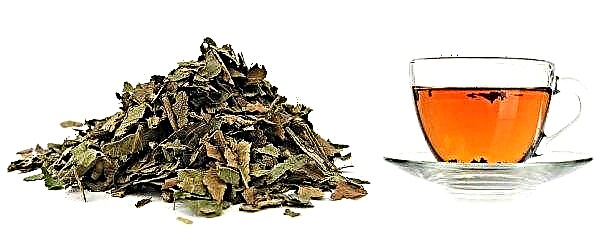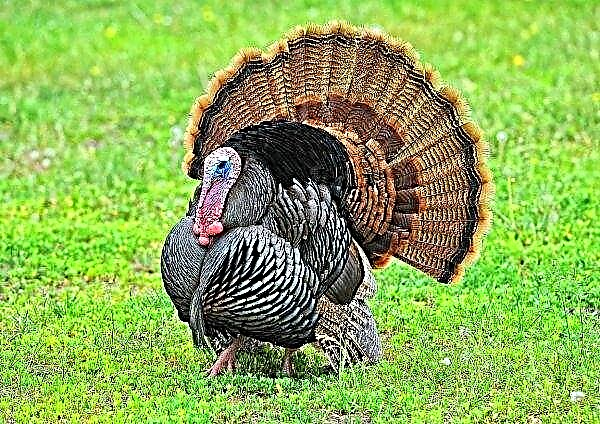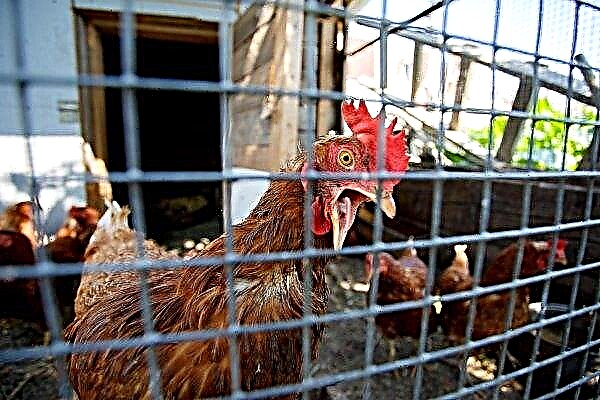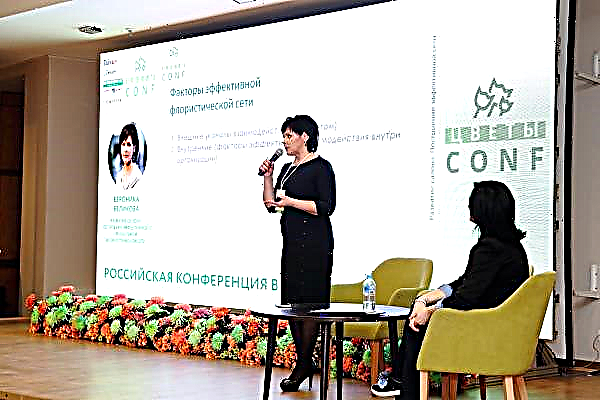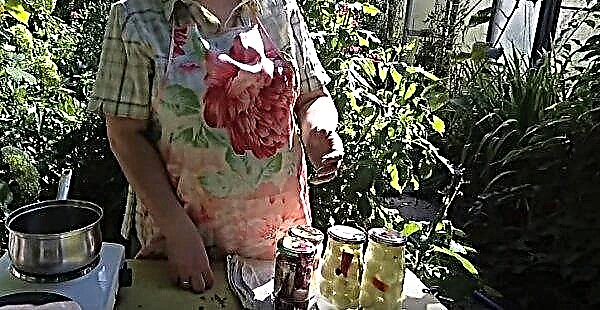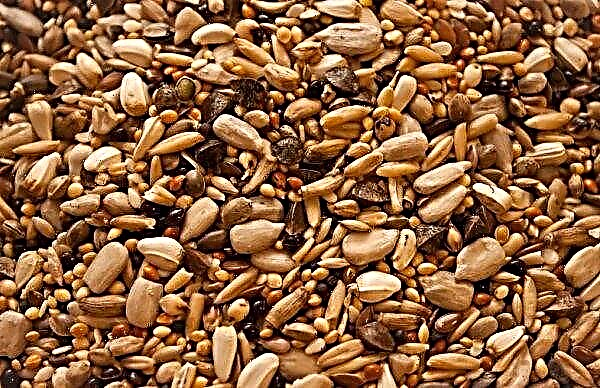Diseases of the eyes in chickens are divided into infectious and non-infectious. It is impossible to cure eye infections themselves, but to help the feathered pets and create optimal conditions for them under the power of everyone. Not only the condition of the diseased individual, but also the health of the entire livestock depends on the time of the assistance provided. The article will teach you to identify eye diseases by the first symptoms and what to do with the affected birds.
Non-communicable diseases
Non-infectious eye diseases include tumors, injuries, xerophthalmia, and others that do not pose a danger to feathered "neighbors." But it is impossible to ignore the symptoms of diseases, since the lack of adequate treatment can lead to more sad consequences.
Did you know? The first hens were domesticated on the territory of modern Ethiopia almost 3 thousand years ago.
Eye injuries
Such a disease is not contagious, but it is still worth knowing why the bird was injured. This is necessary in order to protect the remaining birds from the same misfortunes.
It is important to regularly inspect the entire stock for mechanical damage. Although trauma may not be a threat, in the absence of therapy it will eventually develop into a more serious problem. In addition, a virus can leak into the open wound and cause inflammation. Feathered eyes often receive mechanical damage from their "tribesmen." From time to time, chickens beat no less than roosters, and it is eyes that are affected in such battles. The bird itself can be injured by running into a sharp object. If there is a lot of dust in the chicken coop, dust, another foreign object or insect can get into the visual organs.
Feathered eyes often receive mechanical damage from their "tribesmen." From time to time, chickens beat no less than roosters, and it is eyes that are affected in such battles. The bird itself can be injured by running into a sharp object. If there is a lot of dust in the chicken coop, dust, another foreign object or insect can get into the visual organs.
Recognize eye injuries by such signs:
- the eye is swollen;
- redness, itching of the eyelids and epidermis are noticeable;
- the eye is watery.
Important! If the wound was not detected immediately, and inflammatory changes began, then this can result in conjunctivitis. Therefore, you need to try to recognize the damage on time.
To prevent eye injury, it should be monitored so that the bars are not very high (60-90 cm from the floor). It is also necessary to keep the premises and the place of walking clean, getting rid of sharp objects and interference, about which birds can be injured.
Tumors
A tumor is a common ailment, which is expressed by a growth on the eye, can have a variety of shapes and sizes. Often such eye diseases form as a result of swelling or swelling of the eyes.

The main signs of tumors are:
- redness of the sore eye;
- swelling and swelling;
- a tumor forms (usually on the lower eyelid);
- eyes are watery;
- visual acuity is lost.
If a tumor appears, you should immediately contact your veterinarian, since most often surgery requires surgery. During the operation, the growth is removed and the affected area is thoroughly sprayed with silver nitrate. Further, the eyes of the bird are regularly treated with a suspension of orthoboric acid.
If the tumor is found in the embryo itself, then it is enough for the chicken to conduct therapy aimed at saturating the vitamins of group A and D.
Important! Today, the cause of the appearance of growths is not clearly identified, but it is noted that often they appear after the use of feathered worms.
Vitamin deficiency
With insufficient intake of vitamins, the mucosa loses the protective layer, resulting in atrophy and necrosis of the lacrimal glands. Night blindness (hemeralopia) progresses, the retina ceases to respond to light pathogens.
The coarse particles of the mucosa clog the lacrimal gland, which entails an entire eyeball abscess (panophthalmitis) and a corneal ulcer (keratomalacia).
Eye complications in birds may appear as a result of a deficiency or incomplete absorption of vitamin A.

Signs of such a problem are:
- lag in the development of chickens;
- peeling of the skin;
- feather baldness;
- drop in egg production;
- hardening of the mucosa;
- loss of visual acuity and even absolute blindness.
To diagnose vitamin deficiency, an egg yolk is examined in a laboratory. In the diagnosis, infectious diseases (respiratory tract, mycoplasmosis, Marek's disease) similar in pathogenesis are excluded.
The treatment, as well as the prevention of vitamin deficiency, is a new diet, supplemented by vitamin A.
Chickens should be given:
- carrot;
- chopped fresh grass;
- bone meal;
- fish oil or its equivalent.
Did you know? The chicken itself recognizes damaged eggs and throws them out of the nest.
Conjunctivitis
The conjunctiva is a mucous film located on the posterior area of the eyelid and the anterior region of the eye. Inflammatory processes in this film are called conjunctivitis.
It is considered the most common disease. Conjunctivitis progresses as a result of untreated injuries, stagnation of air, excessive humidity, lack of vitamin A, small particles or infection in the eyes.
Regardless of the factors that caused the disease, the manifestations in birds are always the same:
- eyes close, eyelids rise with difficulty;
- swelling appears;
- purulent discharge occurs;
- general weakness;
- loss of appetite;
- vision deteriorates.

Pharmacies today offer many drugs that help get rid of the disease, but before treatment, you should consult your veterinarian. Therapy is prescribed depending on the phase of the disease.
If conjunctivitis is detected at the very beginning, you can fight it yourself. To do this, apply a cotton swab dipped in strong tea or chamomile tea to the eyes. The procedure is performed several times a day.
At the same time as washing the eyes, chickens are given vitamin A. It is best to buy it in liquid form and mix in the drink at the rate of 0.5 ml per ½ cup of liquid. To prevent the appearance of conjunctivitis, chickens are provided with decent living conditions and nutrition. It is important to ensure that there is no air draft in the room.
Important! If the inflammation is not treated, then the eyes atrophy and absolute blindness sets in.
Xerophthalmia
If chickens swell and close their eyes, but there is no purulent discharge, they are likely to get xerophthalmia. This is an ailment in which a malfunction occurs in the metabolic processes in the epithelial cells. Cells corne and die. The disease manifests itself on the skin around the eyes. The main cause of the disease is vitamin A deficiency.
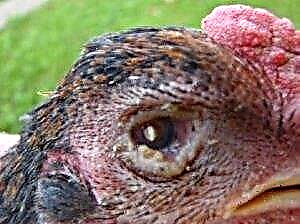 But the disease can develop in the presence of other factors:
But the disease can develop in the presence of other factors:
- non-compliance with the humidity regime in the chicken coop;
- chemical burns of the mucous membrane;
- eye damage;
- natural aging.
In addition to swelling, the following symptoms are also observed:
- dryness, clouding and thinning of the cornea (and if the disease is neglected, exfoliation);
- cracking and swelling of the eyelids;
- dysfunction of the lacrimal glands.
Diagnosing xerophthalmia is quite difficult, since there are no obvious signs of this disease. Diagnosed by the reaction of birds to bright light and inflamed vessels. For the treatment of xerophthalmia, it is not at all necessary to feed the bird with medicines - it is enough to improve the quality of nutrition. With severe vitamin deficiency for 5-10 days, vitamin A is administered intramuscularly.
As a prevention, the following products are included in the diet:
- Fresh carrots
- fish fat;
- green mass;
- actually vitamin A.
Did you know? Egg protein is the standard: all other proteins are evaluated relative to the egg.
Ammonia blindness
This disease affects mainly young growth at the age of 1.5-2 months. Ammonia blindness is terrible because it affects not only the visual ability of the feathered, but also its condition as a whole. The sick chicken quickly goes blind, lags behind in development, apathy appears.
The main reason is the increased concentration of ammonia in the room air. This factor arises due to inferior and irregular cleaning of the house, as well as the lack of disinfection.
The main manifestations of ammonia blindness are:
- abscess of the mucous membrane of the film;
- growth retardation of young animals;
- improper development;
- discharge from the nose;
- loss of vision.
 Affected eyes for 5-7 days are washed twice a day with chamomile broth or strong tea, and the diet is adjusted. Feathers are cleaned from feathers with a soft cloth dampened with warm water. At the same time, they disinfect the territory, processing dishes and perches.
Affected eyes for 5-7 days are washed twice a day with chamomile broth or strong tea, and the diet is adjusted. Feathers are cleaned from feathers with a soft cloth dampened with warm water. At the same time, they disinfect the territory, processing dishes and perches.To save chickens from such a disease in the future, it is enough to enrich the diet of birds with vitamin A and systematically clean the house.
Did you know? The smallest 2.58 g chicken egg has been reported in China.
Infectious diseases
If the bird has festering eyes, you need to know how to treat it. And if it is not difficult to cope with non-communicable problems, then viral diseases are dangerous because they spread quite quickly among the livestock. Therefore, an important point is the timely detection of symptoms.
Hemophilia (infectious rhinitis)
Hemophilosis is a viral disease caused by the activity of the small cocciform motionless gram-negative bacteria Hemophilus gallinarum. This virus is able to remain viable for up to a year, and lives in water for 3-7 months. The source of infection are:
- unhealthy or ill individuals and chickens;
- poorly crafted inventory;
- feed, water;
- dust flooring.
The disease can be of a mass nature, covering 50-70% of the livestock. The main manifestations of the disease:
- lacrimation, watery nose, sneezing;
- plugs appear in the nose;
- wheezing occurs when breathing;
- the neck and wings are stained with secretions;
- purulent-fibrinous processes in the conjunctiva take place;
- swelling of the subcutaneous fibers of the warts is noticeable near the eyes, on the jaw and neck;
- redness of the skin;
- bird depletion;
- disappearance of egg production;
- hens noticeably limp;
- the skin turns yellow;
- catkins and crest fade.

Often, hemophilia is accompanied by swelling of the head, for which the disease was given the second name - “owl head syndrome”.
An autopsy in the airways reveals serous-purulent or fibro-caseous masses, swelling, and excess blood in the throat and trachea. A correct diagnosis can be made only on the basis of clinical manifestations and epidemiological data for the region.
The course of treatment is prescribed depending on the phase of the disease. At the very beginning, the following procedures are performed:
- A swab soaked in strong tea, a suspension of furatsilin or tetracycline cleanse the nasal passages and sinuses. So the bird is given the opportunity to breathe normally.
- Penicillin or Streptomycin is injected under the skin. They are also added to water and birds are fed for 5-7 days. As medicines, you can use "Disulfan", "Etazol", "Phthalazole", "Sulfadimezin."
It is also recommended to divide the livestock in the chicken coop so that the birds of different ages are separate, and isolate the "youth" up to the age of 1.5 months.
Important! Vitamin A deficiency, malnutrition and living conditions favor the development of hemophilia.
Marek's disease
The disease is quite common among poultry. The virus provokes the development, therefore, diseased individuals are urgently isolated. In addition to the eyes, Marek’s disease affects the nervous system, as a result of which the chicken can become completely blind. Its main manifestation is an excessively narrowed pupil. But there are also such signs:
- sagging tail;
- lameness, paresis of paws;
- the iris becomes gray;
- diarrhea;
- termination of oviposition;
- drying and blanching of the ridge.
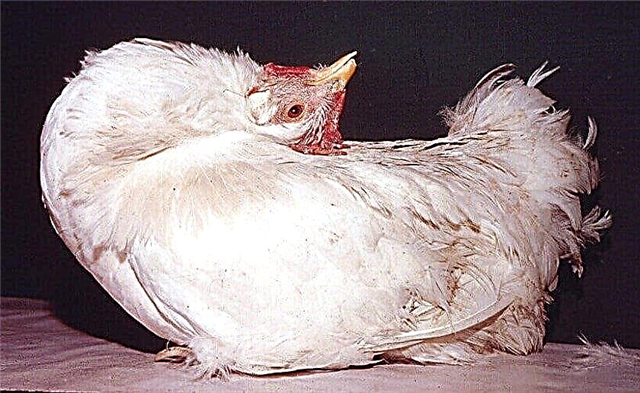 Today, the disease in neglect is not being treated, and the affected bird is simply destroyed. At the initial stage, “Acyclovir” can be used, but its effect is questioned by experts.
Today, the disease in neglect is not being treated, and the affected bird is simply destroyed. At the initial stage, “Acyclovir” can be used, but its effect is questioned by experts.In order to prevent infection, chickens are vaccinated at day old. For adults, this measure is not suitable - the vaccine on mature birds simply does not work.
Important! Although hemophiliasis is treatable, its effects are observed for a long time: egg production decreases by 10-30%.
Salmonellosis
This very dangerous disease of an infectious nature affects mainly young and laying hens. It can spread through eggs and is characterized by high mortality. A sick bird loses sight, loses weight and dies.
In frozen or poorly processed carcasses, the infection lives 2-3 years, in the soil - up to 4 months, and on the partitions - 5 months. Salmonellosis affects mainly individuals with weak immunity.
The main symptoms that can be observed in poultry are as follows:
- redness of the eyes;
- lameness;
- breathing becomes hoarse;
- swelling appears around the eyes;
- diarrhea;
- eyelids become thinner and stick together;
- loss of appetite;
- drowsiness;
- transparent mucus flows from the eyes;
- shell deformation in laying hens.
 If these signs appear, you should immediately consult a veterinarian who will prescribe adequate treatment. The basis of therapy is the use of antibiotics (Sulfanilamide, Baytril, Chlortetracycline, Enrofloxacin, Streptomycin). The course of treatment is 10 days.
If these signs appear, you should immediately consult a veterinarian who will prescribe adequate treatment. The basis of therapy is the use of antibiotics (Sulfanilamide, Baytril, Chlortetracycline, Enrofloxacin, Streptomycin). The course of treatment is 10 days.Did you know? Hens are absolute leaders among numismatic bird species - their image is fixed on coins of 16 countries.
Colibacillosis
This infectious disease is caused by virulent variations of E. coli. It can occur both separately and act as a secondary disease. Mostly, young animals and chickens with low immunity are affected.
The causative agent of colibacteriosis is the intestinal bacterium Escherichia coli, which can live in water and soil for up to 4 months. The foci of infection are:
- droppings of sick birds;
- eggs of sick individuals;
- contaminated equipment;
- food, water.
- drowsiness;
- loss of appetite;
- jelly-like stool, diarrhea;
- the bird is thirsty;
- productivity decreases;
- oviduct falls out.
 In the treatment of colibacteriosis, the same drugs are used as with salmonellosis. Antibiotics mixed into the food will be effective only as a preventative measure, since diseased individuals generally refuse food. As a prophylaxis of chickens, antimicrobials are given periodically.
In the treatment of colibacteriosis, the same drugs are used as with salmonellosis. Antibiotics mixed into the food will be effective only as a preventative measure, since diseased individuals generally refuse food. As a prophylaxis of chickens, antimicrobials are given periodically.Did you know? Chicken distinguishes more shades of flowers than a person. People can distinguish almost a million shades, and chicken - more than 100 million.
Mycoplasmosis
The disease can be a consequence of a chronic catarrhal illness. Mycoplasmosis is able to affect all age groups and is found among poultry quite often. The causative agent of the disease is mycoplasma.
Infected individuals may have the following symptoms:
- inflamed, reddened membrane of the eyes;
- leakage from the nasal cavity;
- difficulty breathing.
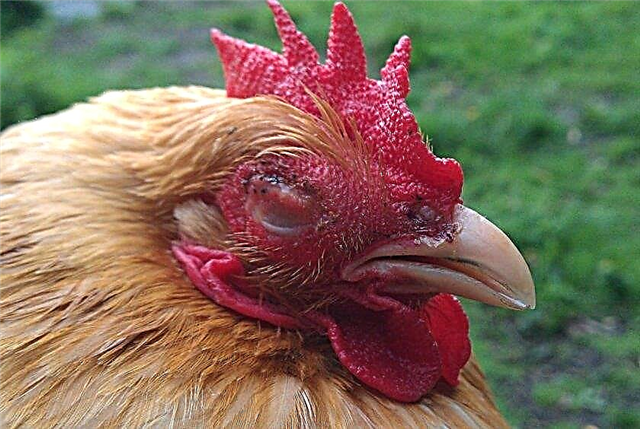 It is not necessary to prescribe treatment on your own if the eye is foaming - at first a clear diagnosis is made. Individuals weakened by mycoplasmosis are destroyed. It is permissible to give the bird antibiotics as a prophylaxis for three days (Oxytetracycline, Chlortetracycline).
It is not necessary to prescribe treatment on your own if the eye is foaming - at first a clear diagnosis is made. Individuals weakened by mycoplasmosis are destroyed. It is permissible to give the bird antibiotics as a prophylaxis for three days (Oxytetracycline, Chlortetracycline).Infectious laryngotracheitis
This variant of the infectious disease is characterized by transience. Basically, they become infected with laryngotracheitis in the summer and autumn. The incubation period lasts 3-12 days. The disease affects the larynx, nasal cavity, trachea.
Infectious laryngotracheitis is caused by inflammation of the conjunctiva or other mucous membranes. The main causes of laryngotracheitis are:
- weak immunity;
- dust content and high humidity in the chicken coop;
- poor ventilation;
- poor quality food.
- rhinitis;
- apathy;
- decreased or complete loss of appetite;
- breathing accompanied by wheezing and whistling;
- the bird coughs, sneezes, spits;
- swelling of the larynx and the appearance of cheesy discharge in it;
- conjunctivitis, vision disappears.
 It is worth noting that both eyes are most often not affected. It is often observed that only one eye suddenly closes. This is precisely the reason for closer monitoring of the bird.
It is worth noting that both eyes are most often not affected. It is often observed that only one eye suddenly closes. This is precisely the reason for closer monitoring of the bird.The super-sharp form appears unexpectedly and can cover the whole population in a day. This type of laryngotracheitis manifests itself in the form of such symptoms:
- suffocation;
- frequent head jerking;
- curdled discharge in the larynx;
- hoarse, labored breathing;
- coughing up blood;
- termination of oviposition.
Even after healing, the chickens do not recover completely, losing egg production by almost 1/3. From ill individuals it will not be possible to get a healthy brood - the causative agent of laryngotracheitis is transmitted with the mother's egg. In advanced cases, the bird is killed.
As a precautionary measure, it is recommended to vaccinate chickens immediately after hatching, observe sanitary standards and properly feed the birds.
Infectious bronchitis
Finding out why chickens watery eyes, you should carefully monitor the condition of the bird as a whole. The cause may be an ailment that is associated with the respiratory tract - infectious bronchitis. This disease affects the respiratory and reproductive systems of birds and is expressed as eye damage.
- stress
- drafts;
- hypothermia;
- excess protein in the diet.
There are such signs of infectious bronchitis:
- drowsiness, depression;
- cough, wheezing;
- rhinitis;
- developmental slowdown;
- drooping wings;
- signs of sinusitis and conjunctivitis;
- decrease in egg production.

Infectious bronchitis is insidious in that it is very difficult to diagnose it at an early stage - its symptoms are similar to other diseases. Only in adults, according to rare signs, it is possible to establish a diagnosis more accurately.
Treatment always involves isolation and the use of antibiotics. In parallel, the chicken coop is disinfected in the presence of birdsandmi 2-hydroxypropanoic acid, triethylene glycol and resorcinol.
As a prophylaxis, control over the hygienic condition of the livestock and vaccination of young animals are proposed. Sometimes vaccination of birds can be carried out before laying.
Important! Chickens with bronchitis after 60-100 days remain carriers of the virus.
So, the reasons that chickens have eye disease can be various: from simple vitamin deficiency or poor living conditions to various viral infections. Therefore, to prevent negative consequences, you should carefully look after your pets and maintain cleanliness in the chicken coop. It is these elementary measures that are the most effective prevention.



